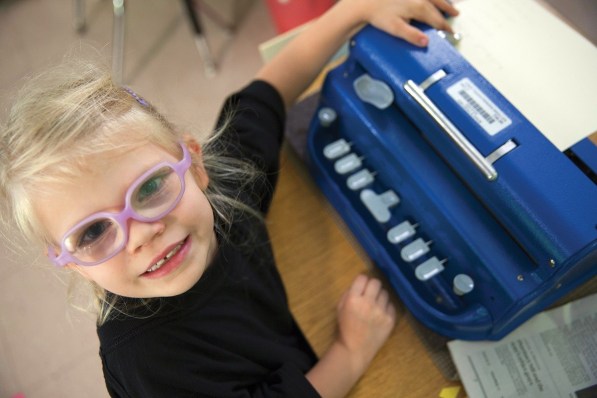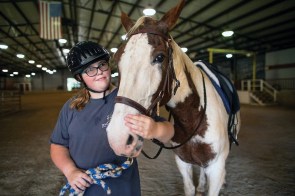By Chuck Chandler
Alabama Newscenter

Had William Seaborn Johnson been like his nine siblings, countless people in the past 160 years might have led diminished lives.
Seaborn was deaf, which inspired his older brother, Joseph, to start a school in 1858 that years later became the Alabama Institute for Deaf and Blind (AIDB). Today, the wide-ranging programs on the huge campus in Talladega are renowned worldwide as the staff continues to break ground training disabled children and adults in 90 different buildings. AIDB’s motto is “Deaf. Blind. Limitless.”
When the school began teaching 21 deaf children sign language, reading and writing at Manning Hall, it was taking the first small steps toward a statewide educational network that today serves about 25,000 people annually. The building on the National Register of Historic Places was constructed in 1850 but no longer has classrooms. It is the managerial epicenter of Alabama’s largest employer of blind, deaf and deaf-blind adults.
About 25 percent of AIDB’s 1,300 employees are disabled in some fashion. AIDB has five Talladega campuses, eight regional centers across Alabama and welcomes students from all 67 counties. Tuition, room and board are free for Alabama residents. Some 10,000 elderly people in the state receive assistance for hearing and sight problems.
“Through federal partnerships, we’re actually serving deaf and blind children around the country,” says Lynne Hanner, director of Institutional Advancement and an AIDB employee for 38 years. “We’re the biggest in the U.S. and probably in the world.”
AIDB’s presence in Talladega includes:
- Alabama School for the Deaf, serving 195 students from preschool to 12th grade. About 70 percent of the students live on campus during the week and are transported home every third weekend. The Silent Warriors athletic program includes football, baseball, volleyball and track, and has won championships at every level including national.
- Alabama School for the Blind has 115 students from preschool to 12th grade with the same academic standards as the deaf school. A quarter of the students are totally blind, many of them involved in music classes. The Silent Warriors teams include wrestling, track and goal ball.
- Helen Keller School of Alabama since 1980 has provided instruction – currently to 85 students with multiple disabilities and deaf-blindness.
- E.H. Gentry Technical Facility for 50 years has provided unique vocational and educational rehabilitation for disabled adults, with the goal of attaining skills that lead to employment and independence. It is considered one of the nation’s top vocational programs.
- Alabama Industries for the Blind was founded in 1932 and is the state’s largest employer of legally blind and disabled adults. They no longer make brooms but put together products that include Navy flight deck vests and biodegradable mops, as well as all neckties worn by the U.S. armed forces.
A major addition under construction is the Joe Tom Armbrester Agricultural Center, built in part with an anonymous $1 million donation to honor the namesake. The institute has acquired many acres of adjacent farmland through the years, which at one time helped feed students, but is now used primarily to teach agriscience courses and house farm animals. There are 30 acres of fruit orchards and a fishing pond.

Six months ago, the $2 million Alabama Power Foundation Nursing Clinic opened behind Manning Hall to provide healthcare and medications to AIDB students, faculty and staff.
“You look across AIDB and there are so many heroes,” says Hanner, who co-authored the 150-year history book “The Ties that Bind” about the institute. “These folks are overcoming significant challenges, and excelling.”
Among AIDB’s leadership, 25 administrators are deaf or blind, many of them, like CFO Jonathan Sherbert, being graduates of the system they now watch over. Hanner keeps a second-grade photo of Sherbert,who oversees an $80 million annual budget, of which $54 million comes from the state and the rest from grants and donations.
“When I came here, I didn’t want to leave,” says Hanner, a Talladega native who worked one year at WBHM in Birmingham before coming home.
“It’s a calling,” she says. “Lots of employees stay 30 or 40 years. The president’s secretary, Amanda Fuller, has been on staff 58 years. We just wouldn’t be anywhere else.”
A relative newcomer to the team is President John Mascia, whose business cards are printed in Braille and regular type. He joined AIDB six years ago but has been involved with the institute for longer. Although he is from New York, his grandmother was a Selma native and his late aunt taught school there.
“I just couldn’t believe in this sweet little town of Talladega there was the most comprehensive program in the country,” Mascia says of the first time he visited AIDB. “I knew this immediately because I’ve been to every program nationally. It wasn’t the size of the campus or the buildings, but the people here who impressed me with their skills and their compassion.”
Mascia says fulfilling the mission of the institute is “not just a job” for him or other employees. He admits to being inspired and often surprised by the accomplishments of students and teachers alike. And he credits the partnership between the institute, townspeople and businesses with allowing AIDB to succeed and prosper into a third century.
“Alabama should be so proud as a state that very early on it became a civil rights advocate for people with sensory disabilities,” Mascia says. “Our students’ future is absolutely limitless.”
This story originally appeared in Alabama Power’s Powergrams.





